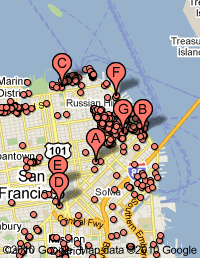
With the rise of smart phone use in the US, (Google Android and iPhone are currently reporting roughly 500,000 activations a day ) it’s more important than ever to have your Google places listing up to speed because when people use voice search on Android phones, the first results they see are from Google local.
Let’s start with a few facts. Did you know that;
- 73% of all online activity is related to local content (Google)
- 82% of local searchers follow up with a phone call or show up on your doorstep (TMP/comScore)
- 66% of Americans use local search to find local businesses (comScore)
Another reason to take Google Places seriously is the recent changes and enhancements that were rolled out. Now you will notice the map with local businesses appears above the ads on the right side. Also worth noting is that the local listings are appearing above all organic search results and have taken up more space, pushing the organic listings further down the page.
With the recent Google launch of Hotpot, Google is entering the local recommendation space. Hotpot combines Google Places, the places you like and the places your friends like making it even easier for people to make decisions about which local businesses to patronize.
Not surprisingly, marketing on Google Places has gotten very competitive. It used to be you could simply fill out your business listing on Google and see it in the 7 pack a few weeks later. These days, if your listing doesn’t have a 100% score, you can forget about being listed in the first 7 local businesses that Google displays for local results. That said, here are 5 things you can do to get more business from local search:
1. Make sure your Google listing has a 100% score – There are more than 20 different fields you in your Google Places listing and surprisingly most businesses don’t bother to fill them all in. At the end of the day, the difference between showing up on the first page of Google Places or not can boil down to not having a video as part of your listing.
2. Include product or service keywords in your listing description – I would also list one or two of the cities or suburbs where your target market lives. As with any content on the internet, be sure not to over use your keywords. Your description should be written for people with an eye for SEO.
3. Encourage your clients to write a review on your Google places listing – Think about it, if you and 10 local competitors all have 100% scores on your listing, which is fast becoming the case, what will Google use to rank order these businesses? The one component of the profile that is open ended is the review section so in many cases, the business with the most reviews can win the day.
4. Make sure you are listed in your local phone book – I know this sounds counter intuitive but the fact is Google looks to established sources of data to both build their database and check for local business information. If you’re not listed here, it may affect your ability to rank on the first page.
5. Get listed in the other top local directories like:
- Yelp
- Bing
- Yahoo
- Best of the Web
- Hotfrog, and
- Foursquare
You can go to www.getlisted.org to get a score on how effectively your business is taking advantage of the free listings at the major search engines.
Local listings & SEO have always been important for small business online marketing, but now they’re essential. If you follow the advice above, your business listing will have a better chance of getting on the first page of the search results and in many cases, may even appear above the organic search results.


